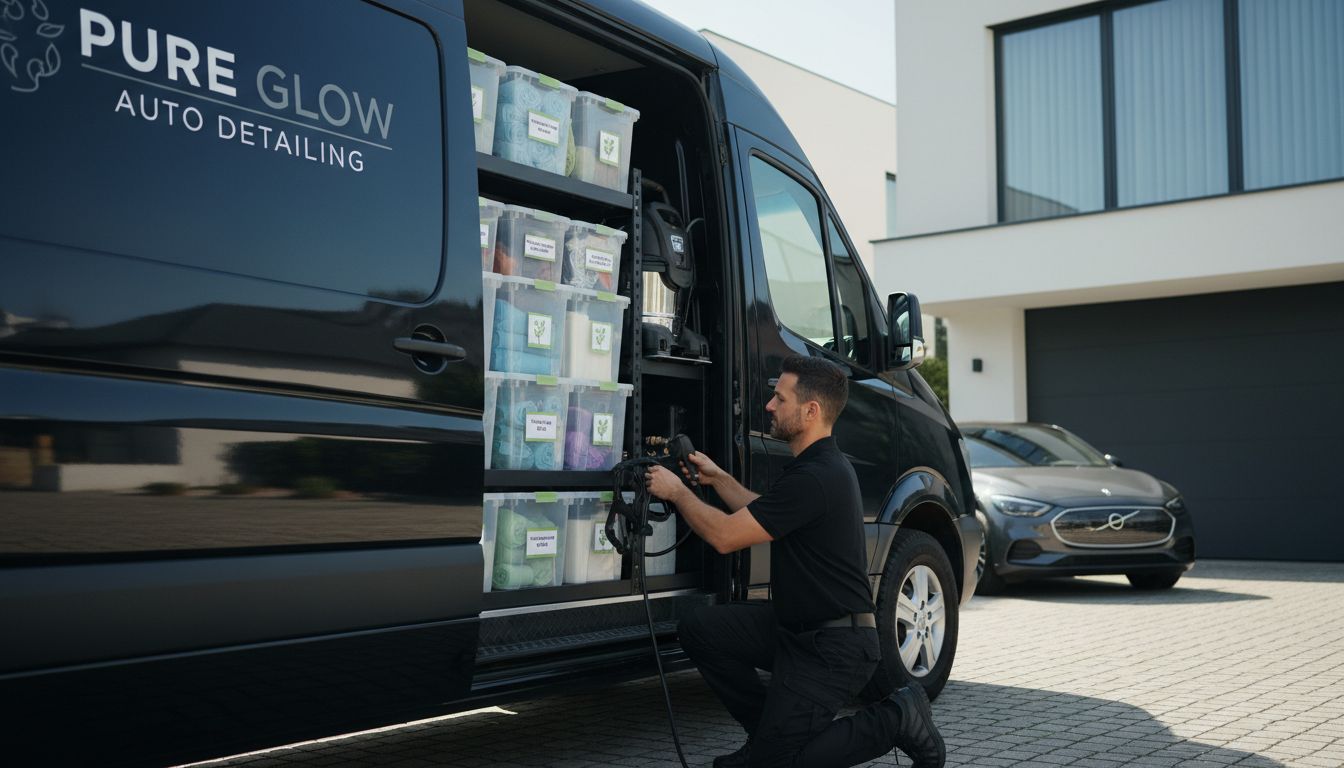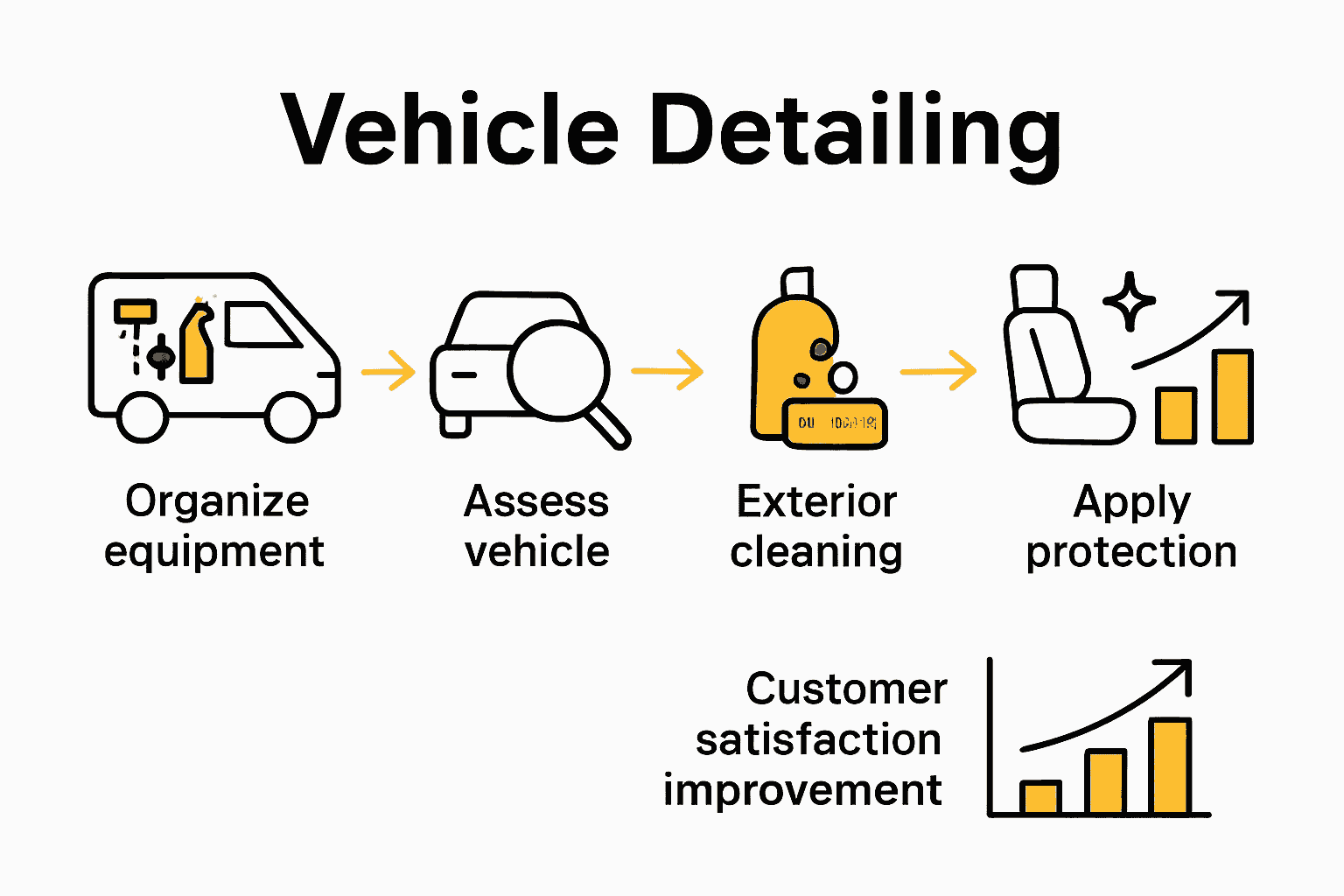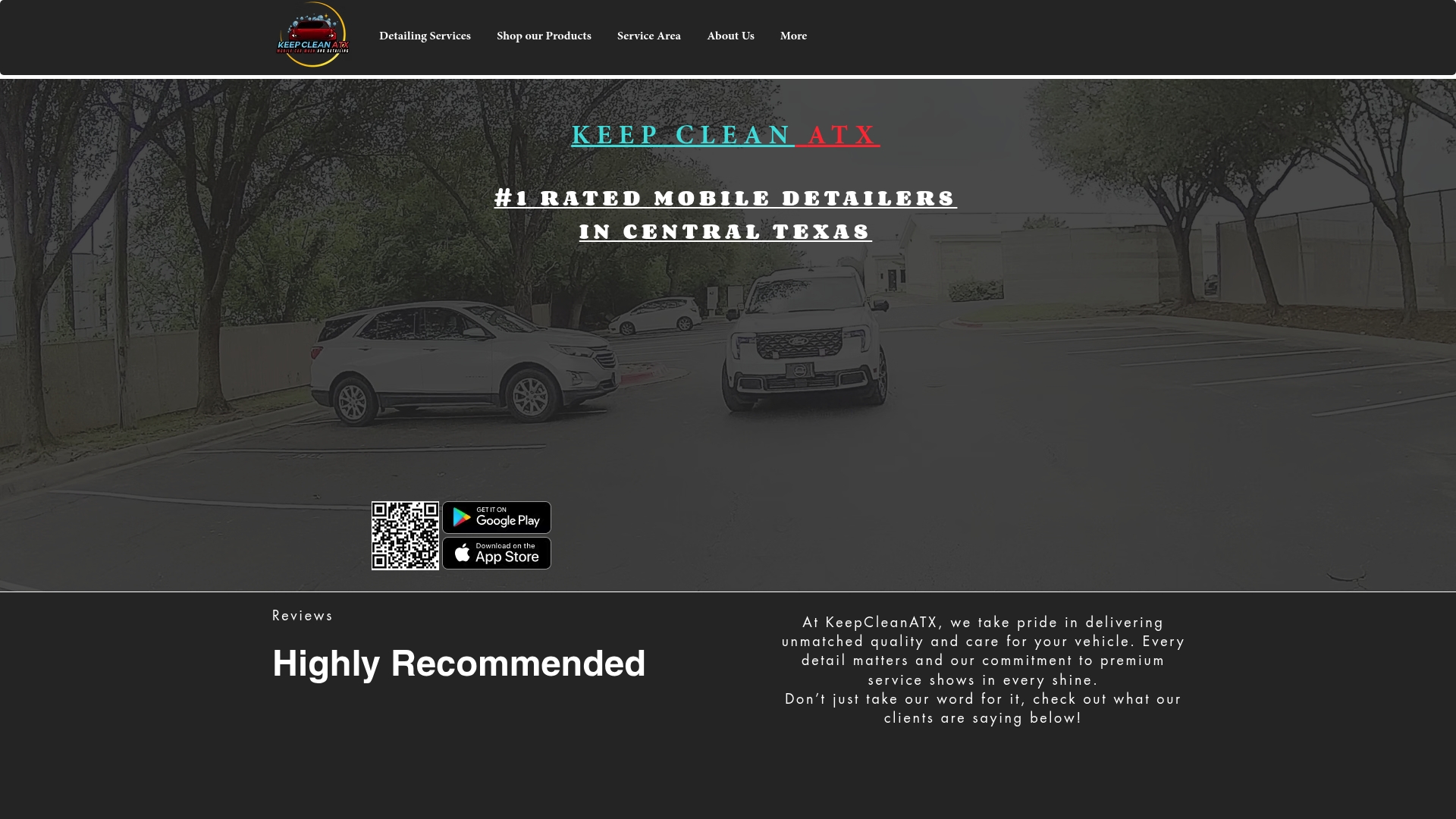Mobile Auto Detailing Workflow for Pristine Results
- 5 days ago
- 9 min read

Launching a mobile auto detailing business means more than just cleaning cars—it requires precision, organization, and a sharp focus on professionalism. With the demand for mobile detailing growing, customers expect results that rival traditional shops and eco-friendly practices. Nearly 60 percent of car owners now seek professional detailing services to protect their investment. This guide breaks down the step-by-step process that helps you organize your equipment, master cleaning techniques, and deliver top-tier results that keep customers coming back.
Table of Contents
Quick Summary
Key Point | Explanation |
1. Organize Equipment Efficiently | Use sturdy containers and an organized system to maximize workspace and protect tools during transport. |
2. Assess Vehicle Surfaces Carefully | Thoroughly inspect surfaces to determine the right cleaning methods and products for optimal detailing. |
3. Use Quality Products for Cleaning | Invest in biodegradable and pH neutral cleaners to ensure effective cleaning while minimizing environmental impact. |
4. Apply Protective Treatments Skillfully | Use specialized applications like wax and ceramic coatings to enhance surface protection and appearance. |
5. Prioritize Customer Satisfaction | Conduct a walkthrough with clients post-service to confirm quality, address concerns, and foster future relationships. |
Step 1: Prepare and Organize Mobile Detailing Equipment
Successful mobile auto detailing starts with strategic equipment organization and selection. According to umatechnology.org, investing in high-quality supplies and equipment is fundamental to delivering professional results for your customers.
Begin by selecting a reliable vehicle that can serve as your mobile detailing command center. Ideally, choose a van or truck with substantial cargo space to accommodate your cleaning arsenal. Your equipment checklist should include essential cleaning supplies such as car shampoos, specialized waxes, polishes, degreasers, microfiber towels, multiple brushes, and various applicators. For comprehensive cleaning capabilities, acquire critical equipment like pressure washers, industrial vacuums, steam cleaners, buffing machines, and a portable generator to ensure power availability at every job site.
When organizing your mobile workspace, create a systematic storage approach that maximizes efficiency and minimizes equipment damage. Use sturdy, waterproof containers with secure compartments to separate chemicals, protect delicate tools, and prevent spills during transportation. As recommended by skillupwa.org, incorporate an onboard water tank system to enable seamless detailing without worrying about water access, and prioritize environmentally friendly practices by selecting biodegradable cleaning products.
Pro tip: Label all your containers clearly and create a standardized inventory checklist. This practice ensures you never forget critical supplies and can quickly restock after each detailing session. Your next step involves learning the precise techniques for using these carefully selected tools and maintaining them in top condition.
Step 2: Assess and Protect Vehicle Surfaces
Effective mobile detailing begins with a thorough surface assessment to ensure optimal cleaning and protection. According to umatechnology.org, understanding environmental regulations and using eco-friendly products is crucial for protecting both vehicle surfaces and the surrounding environment.
Start by carefully inspecting the vehicle for different surface types paint, clear coat, glass, chrome, plastic, and leather. Each surface requires a specific approach to cleaning and protection. Look for signs of contamination like road grime, oxidation, water spots, or minor scratches that will influence your detailing strategy.

Pay special attention to areas prone to dirt accumulation such as wheel wells, lower panels, and around trim pieces. Identify any existing paint imperfections or delicate areas that might need extra care during the cleaning process.
As recommended by basmaa.org, prioritize environmentally responsible practices by using absorbent materials like kitty litter to manage any oil or grease spots and avoiding chemical runoff into storm drains. When selecting cleaning products, choose solutions specifically designed for each surface type to prevent potential damage. For instance, use gentle pH neutral cleaners on ceramic coatings, specialized leather conditioners for interior surfaces, and automotive-specific glass cleaners.
Pro tip: Always test cleaning products on a small inconspicuous area first to ensure compatibility and prevent potential surface damage. Your next step involves preparing the specific cleaning solutions and tools tailored to the surfaces you have identified.
Step 3: Clean Exterior with Optimal Products
Mobile auto detailing demands a strategic approach to exterior cleaning that balances effectiveness with environmental responsibility. According to umatechnology.org, selecting high-quality cleaning supplies is crucial for achieving professional results while appealing to eco-conscious customers.
Begin your exterior cleaning process by preparing a comprehensive washing strategy. Select specialized car shampoos designed to safely remove dirt and grime without damaging the vehicle’s paint. Start from the top of the vehicle and work your way down, using separate microfiber towels for different surfaces to prevent cross-contamination. Utilize a two-bucket method one for clean soapy water and another for rinsing to minimize scratching. Pay extra attention to heavily soiled areas like wheel wells, lower panels, and around trim pieces where dirt tends to accumulate more aggressively.
As recommended by basmaa.org, prioritize environmentally responsible cleaning practices. Use biodegradable cleaning solutions and implement strategies to prevent chemical runoff into storm drains. When possible, use waterless cleaning techniques or capture and properly dispose of wastewater. Choose pH neutral cleaners that are safe for various surface types and avoid harsh chemicals that could potentially damage the vehicle’s finish.
Pro tip: Always rinse your cleaning tools frequently and use clean microfiber towels to prevent introducing new contaminants to the vehicle surface. Your next step involves precise drying and preparing the surface for additional protective treatments.
Step 4: Detail Interior Using Specialized Techniques
Interior detailing requires a systematic and comprehensive approach that transforms a vehicle from simply clean to meticulously restored. According to umatechnology.org, offering comprehensive interior detailing services demands investment in high-quality equipment and specialized techniques to achieve professional results.
Begin by completely removing all loose items from the vehicle and preparing your specialized cleaning tools. Use a powerful vacuum with multiple attachments to thoroughly clean every crevice including under seats, around dashboard controls, and in tight corner spaces. Tackle different interior surfaces methodically start with fabric surfaces using appropriate upholstery cleaners, then move to hard surfaces like dashboards and consoles. For leather surfaces, apply dedicated leather conditioning products that clean and protect without causing damage. Pay special attention to frequently touched areas like steering wheels, gear shifts, and door handles which accumulate significant amounts of dirt and skin oils.
As recommended by skillupwa.org, prioritize environmentally responsible cleaning practices by selecting biodegradable cleaning products and implementing proper waste management techniques. Steam cleaning can be an excellent method for sanitizing and deep cleaning various interior surfaces without using harsh chemicals. Utilize microfiber towels for wiping surfaces to prevent scratching and ensure a streak-free finish. Different materials require different cleaning approaches leather needs conditioning, fabric needs specialized shampooing, and plastic surfaces require gentle yet effective cleaning solutions.
Pro tip: Always work from top to bottom in the interior to prevent re-contaminating cleaned surfaces. Your next step involves final inspection and applying protective treatments to maintain the restored interior condition.
Step 5: Apply Protective Finishes and Treatments
The final stage of mobile auto detailing transforms a clean vehicle into a protected masterpiece that resists environmental damage and maintains its pristine appearance. According to umatechnology.org, offering comprehensive protective treatments such as waxing, clay bar treatments, polishing, and ceramic coatings represents the pinnacle of professional detailing services.
Begin by selecting the appropriate protective treatment based on the vehicle’s specific surface condition and your customer’s desired outcome. For paint surfaces, start with a clay bar treatment to remove microscopic contaminants that standard washing cannot eliminate. Follow this with a precise polishing process to eliminate minor scratches and restore the paint’s original luster. Apply high-quality wax or ceramic coating in thin, even layers using specialized applicator pads. Work in small sections systematically to ensure complete coverage and prevent uneven application. Pay extra attention to areas prone to environmental stress such as the hood, roof, and front panels which experience more direct sunlight and potential paint damage.
As recommended by skillupwa.org, maintain environmentally responsible practices during protective treatments. Choose biodegradable products that provide superior protection while minimizing ecological impact. Consider offering package deals that include multiple protective layers to provide comprehensive vehicle preservation. Different surfaces require different approaches leather needs conditioning, vinyl requires specific protectants, and paint demands careful sealing techniques to maintain its shine and resilience.
Pro tip: Always work in a shaded area with moderate temperature to prevent protective treatments from drying too quickly or creating uneven application. Your final step involves a comprehensive inspection to ensure every surface has been perfectly treated and protected.
Step 6: Verify Quality and Ensure Customer Satisfaction
The final stage of mobile auto detailing is about delivering exceptional results and creating lasting customer relationships. According to umatechnology.org, verifying quality and meeting customer expectations is crucial for building a reputable mobile detailing business that encourages repeat service and positive referrals.
Conduct a comprehensive walkthrough with the customer immediately after completing the detailing service. Use professional lighting to highlight the vehicle restoration and point out specific improvements such as paint correction, surface protection, and interior cleanliness. Invite the customer to inspect each area carefully and address any questions or concerns immediately. Pay special attention to details like trim restoration, glass clarity, wheel shine, and overall surface smoothness. Document the before and after condition using high quality photographs that demonstrate the transformative work performed.
As recommended by skillupwa.org, maintain transparency about your services and commitment to environmental responsibility. Explain the specific treatments applied, the products used, and provide care instructions to help customers maintain their vehicle between professional detailing sessions. Consider offering follow-up packages or maintenance programs that encourage ongoing customer engagement and showcase your dedication to long term vehicle preservation.
Pro tip: Always follow up with a customer satisfaction survey within 48 hours of service to demonstrate your commitment to continuous improvement and exceptional customer experience. Your final objective is to convert this service into a long term professional relationship that generates repeat business and positive referrals.

Achieve Showroom Shine with Expert Mobile Detailing Solutions
Taking your mobile auto detailing to the next level means overcoming the challenges of using the right products and techniques to protect every surface and deliver flawless results. The detailed workflow highlights how organizing your equipment, selecting the ideal cleaning agents, and applying protective treatments are key steps toward lasting vehicle care. At Keep Clean ATX, we understand that humidity, dirt buildup, and environmental wear can be frustrating to manage on your own. That is why we provide premium, eco-friendly products designed to simplify every phase of your detailing process — from deep interior cleaning to exterior protection.
Elevate your detailing services today with our carefully curated range of Exterior Care and Interior Care products to ensure professional-grade results and satisfied customers.

Don’t settle for partial results or quick fixes. Visit Keep Clean ATX now to explore our full selection of expert-approved car care essentials at All Products. Start transforming every job into a pristine finish customers can trust. Your next-level detailing experience starts here.
Frequently Asked Questions
What is the first step in the mobile auto detailing workflow?
Successful mobile auto detailing starts with preparing and organizing your equipment. Choose a reliable vehicle with ample storage, then compile essential cleaning supplies and equipment like pressure washers and steam cleaners to ensure you’re ready for all jobs.
How should I assess vehicle surfaces before detailing?
Begin by conducting a thorough inspection of the vehicle to identify different surface types and any imperfections. Look for issues like scratches or contamination, and take note of areas that may need extra care during the cleaning process to tailor your detailing strategies effectively.
What are the key techniques for cleaning a vehicle’s exterior?
Use a two-bucket method to wash the exterior, starting from the top and moving downwards. This technique minimizes scratches and allows you to control the cleanliness of your water, ensuring a thorough wash without damaging the paint.
How can I ensure effective interior detailing?
Start by removing all loose items and then vacuum the entire interior, including hard-to-reach areas. Use specialized cleaning products for each type of interior surface, like upholstery cleaners for fabric and conditioners for leather, to restore the vehicle’s interior thoroughly.
What protective treatments should I apply after detailing?
After cleaning, select appropriate protective finishes such as wax or ceramic coatings based on the vehicle’s condition. Apply these treatments in thin, even layers to enhance surface resilience against environmental damage.
How do I verify customer satisfaction after detailing?
Conduct a comprehensive walkthrough with the customer to showcase the completed work and address any concerns. Document the before-and-after condition and encourage feedback to reinforce customer relationships and identify areas for improvement.
Recommended

Comments